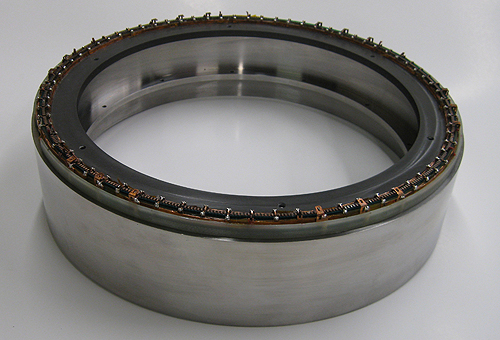ThinGap, LLC is well known for small motors with excellent performance characteristics, eliminating the use of iron and its resultant “lossiness” and depending instead on copper foil, rather than wire windings for its internally clean structure.
The design leads to a lack of “cogging,” that notched feeling found when turning over some motors by hand. Each individual magnet causes the rotor to stop, or “cog,” sometimes making low-speed operation a bit hesitant and smooth transitions difficult. That, the unique ring design and an aluminum housing help carry heat away and allow for an internal controller.
ThinGap have focused on smaller unmanned aerial vehicle applications for many years, but have moved into larger automotive and aircraft products, with one model in particular capturing our attention. The non-production 14090 ring motor is 14 inches in diameter, weighs 25.6 pounds and can deliver 122 kilowatts (163 horsepower) – about 6.4 horsepower per pound and close to the Halbach array motors of Geoff Long and comparable with the ISIS motors developed at Oxford University.
“’ThinGap’s 14-inch electric ring motor allows a ducted fan to develop as much thrust as with a gas engine, which is a game-changing milestone,’ said Rean Pretorius, President, ThinGap, LLC. ‘At 6.4 HP per pound, its power to weight ratio has not been achieved by any electric motor currently in production and exceeds the aerospace engineering threshold of 5 HP per pound. The advantage is much quieter operation for stealth, and less weight, which can be critical for UAV surveillance and close support tactical applications.’”
Highlighting the motor’s potential use as a ducted fan motor, other motors in ThinGap’s lineup claim up to 92-percent efficiency, promising good range from available batteries.


Comments 4
Don’t be fooled by Thin Gap’s claims. A close look at Thin Gap’s own data sheet for the supposed 6.4 hp/lb motor tells the true story:
http://www.thingap.com/pdf/tg14010ds.pdf
Note that the continuous power rating is 24.3 hp, which is only about 1 hp/lb. According to note #1 in the data sheet, the peak torque (which corresponds to the peak power used in the 6.4 hp/lb claim) can only be put out for 0.2 seconds – not very useful for most applications. Also, the peak efficiency of this motor is only 82%, which is significantly less than the 92% alluded to in the posting. You can buy motors from HobbyKing.com that have both better power density and efficiency.
Compare that to the motor being developed at LaunchPoint Technologies, which is capable of 5 hp/lb in continuous operation with around 95% efficiency:
http://www.launchpnt.com/capabilities/electric-motor-design.html
The reason for the poor efficiency and low peak power in the Thin Gap motor is eddy currents in the conductors induced by the magnets in the rotor. This issue is addressed in the LaunchPoint design by using litz wire which reduces the eddy currents to negligible levels. Contact LaunchPoint for more info, if you’re interested…
Author
The blog, and by inference the CAFE Foundation, does not endorse any product or affirm any claims from the product’s manufacturers. Geoff Long presented his motor at the fifth annual Electric Aircraft Symposium and is qualified to offer critiques, although for obvious reasons, not disinterested ones. We invite ThinGap to respond in the spirit of keeping an open and free dialogue.
Is G. Long serious or just a pot calling the kettle black? When I click on his LaunchPoint link I get to see somebody’s hand dart into and out of the start of the video – spin starting an apparently very noisy and very ssshaky electric wheel (or can’t this company yet afford a tripod and dolly for critical PR shoots?). Imagine if this fraction horsepower motor is scaled up to usable power levels and the dB goes with it! I mean “good luck fellas” but they seem to be all over the place with dozens of projects in development for decades and nothing much on the market. Do they even mass produce and sell any electric motor yet? Just sayin….
(Editor’s note: William Dean Howells, editor and good friend to Mark Twain, said, “If we like a man’s dream, we call him a reformer; if we don’t like his dream, we call him a crank.” There are many worthwhile observations in the comments flying around this subject, but we are treading perilously close to name-calling and ad hominem attacks. Please, in future maintain an academic, issue-oriented approach. I worked for the best boss in the world two decades ago. You could argue with him on any aspect of the company’s operation, but once it got personal, he kicked you out of his office and waited for your apology.)
The launchpoint motor is very interesting, but what good is an 8,400 RPM motor in an airplane? It needs a gearbox to turn anything useful, like a propeller, and that adds weight and the drag of the gearbox will cut the efficiency. There’s great technology under way, but neither the motors nor the supporting arguments are showing maturity as yet.